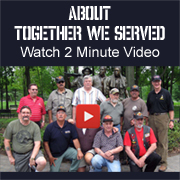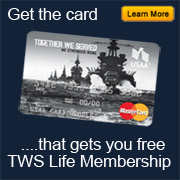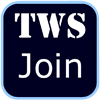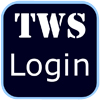 |  |  | |
An up close and personal interview with U.S. Navy Veteran and Togetherweserved.com Member:
MCPO Franklin Schroer U.S. Navy (Ret) (1941-1961)
PLEASE DESCRIBE WHO OR WHAT INFLUENCED YOUR DECISION TO JOIN THE NAVY?
I had just graduated from high school in June 1941. The country was still in the great depression that had lasted through the 1930's. I grew up in a small town and there were almost no jobs available that would lead to a career. The war in Europe was heating  up and most of us felt that it would not be long until the U.S. was drawn into the war so in July 1941, a friend and I decided to join the Navy. up and most of us felt that it would not be long until the U.S. was drawn into the war so in July 1941, a friend and I decided to join the Navy.
We rode his motorcycle to the recruiting station. Neither of us could pass the vision test as we did not wear goggles on the trip. That meant a delay of one week until we could return in an automobile to retake the exam. I was held overnight in Chicago because of an elevated temperature. He went on to Great Lakes and when I went up the next day I was put in another boot company. I did not see him again until after WW II as he was sent to the submarine service.
I had become interested in aviation at an early age and I wanted to become an airplane mechanic. My first airplane ride was at a county fair and was in a Ford Trimotor that had wicker seats. During boot training I selected aircraft mechanics school as my first choice. At that time there were only three aviation ratings for enlisted personnel: Aviation Machinist Mate (AMM), Aviation Metalsmith (AM) and Aviation Ordnanceman (AO); there was another, Naval Aviation Pilot (NAP) but flight training was not open to "boots." I received my first choice of AMM and was assigned to the class 'A' school at Ford Motor Company in Dearborn, MI. Lt. Henry Ford II USNR was my barracks officer. I was impressed by the fact that he acted just like any officer should and it was never obvious as to his social standing. I was impressed by the fact that he acted just like any officer should and it was never obvious as to his social standing.
Upon graduation I was advanced to AMM 3/c and sent to NAS Norfolk for Advanced Based Aviation Training (ABATU) for training on specific airplanes, mine was the PBY Catalina seaplane.
WHETHER YOU WERE IN THE SERVICE FOR SEVERAL YEARS OR AS A CAREER, PLEASE DESCRIBE THE DIRECTION OR PATH YOU TOOK.
When I enlisted in the regular Navy it was for a minority enlistment (we called it a 'kiddy cruise') until I became 21. My mother had to sign papers as my father had died when I was a teen. When I turned 21 we were still engaged in WW II  and the end seemed far off so I extended my enlistment for two years and received a re-enlistment bonus. and the end seemed far off so I extended my enlistment for two years and received a re-enlistment bonus.
After my tour of duty on Guadalcanal and then in Carrier Aircraft Service Unit 9 in the Fiji Islands, I was given orders back to "the States." I traveled back to Pearl Harbor on an old WW I Destroyer USS Waters converted to APD-8.
I then was assigned to a PBY operational training squadron at NAS Jacksonville where we trained crews for wartime fleet service. I was an AMM 1/c (AD rating now) and had the opportunity to fly as a crew member on many training flights, my regular assignment was as structural crew leader. I was in the 100 plane squadron until it was decommissioned after the war ended (VJ-Day). I was sent to Great Lakes to work in the demobilization center. I had been recommended for advancement to CPO and after a few months at Great Lakes I was called before an examination board for an interview. That board was made up of line officers (non-aviation) and I guess they liked my answers to their questions as I was soon promoted to ACMMA (A for acting appointment). That was pay grade 1A in those days. After one year the appointment was made permanent so I decided to make the Navy a career.
 My first assignment as a new chief was to the USS Bennington (CV-20). When I reported aboard she was in dry dock at Portsmouth, VA and I discovered that she was being readied for transfer to the in commission in reserve fleet. I was the only Chief in the air department so I was responsible for supervision of those sailors who were inventorying and preserving all the aviation spaces, equipment and tools. When the ship was transferred into the ready reserve fleet I was given orders to the Assembly and Repair (overhaul and repair) department. After four months there I volunteered for a Navy research project to find an improved method of selecting candidates for flight training. I was then sent to San Diego to Classification Interviewers school and then on to NAS Pensacola. All the duties in this project entailed work out of rate as it involved electrical and mechanical devices. My first assignment as a new chief was to the USS Bennington (CV-20). When I reported aboard she was in dry dock at Portsmouth, VA and I discovered that she was being readied for transfer to the in commission in reserve fleet. I was the only Chief in the air department so I was responsible for supervision of those sailors who were inventorying and preserving all the aviation spaces, equipment and tools. When the ship was transferred into the ready reserve fleet I was given orders to the Assembly and Repair (overhaul and repair) department. After four months there I volunteered for a Navy research project to find an improved method of selecting candidates for flight training. I was then sent to San Diego to Classification Interviewers school and then on to NAS Pensacola. All the duties in this project entailed work out of rate as it involved electrical and mechanical devices.
When I completed that tour I was sent to AD (B) school in NATTC Memphis and then was assigned to ZP-1 at NAS Weeksville, NC. Quite a number of the pilots in that Blimp squadron were dual qualified in heavier than air HTA/LTA so the squadron had 3 airplanes for them to maintain their HTA proficiency. I was assigned as CPO in charge of that unit. Following that tour I requested assignment to the advanced TD school and change of rating.
IF YOU PARTICIPATED IN COMBAT OPERATIONS, PLEASE DESCRIBE THE ACTIONS WHICH WERE THE MOST SIGNIFICANT TO YOU AND, IF LIFE-CHANGING, IN WHAT WAY.
After advanced training at NAS Norfolk I was sent to the South Pacific in September 1942 as a member of "Acorn Red One" which was an aircraft service unit for land based Navy aircraft. We landed on Guadalcanal on November 30 after spending 86 days as a passenger aboard two  transport ships. We landed at Koli Point where the Japanese had landed reinforcements earlier that same month. I was then an AMM 2/c and was assigned to Fighter strip #2 as a mechanic on F4F4 Grumman Wildcat fighters. I also worked as an F4F plane captain for a short time on Fighter #1. transport ships. We landed at Koli Point where the Japanese had landed reinforcements earlier that same month. I was then an AMM 2/c and was assigned to Fighter strip #2 as a mechanic on F4F4 Grumman Wildcat fighters. I also worked as an F4F plane captain for a short time on Fighter #1.
The fight for the island did not end until February 1943 but we had frequent large plane raids into the summer of 1943 by Japanese, several of 100 plane strength. The bombing raids left many aircraft partial or totally destroyed. Each raid left men on the ground dead or wounded.
We also had almost nightly visits by "Washing Machine Charlie" who just flew overhead and dropped an occasional bomb to keep us awake. During one alert for a possible Japanese troop landing I was assigned to a squad to patrol the beach road. Since our unit was tasked with operating an advanced base we had been issued rifles before leaving the US. All enlisted men were issued Khaki uniforms and the officers wore no exposed insignia so any possible sniper could not identify the officers for targets. My weapon was an M1917 Remington Enfield 30-06. Fortunately there were no enemy landings for us to deal with during that alert. Fortunately there were no enemy landings for us to deal with during that alert.
The 15th Naval Construction Battalion was an attached unit under the command of our CO Capt. J.V. Carney. They constructed a bomber field to supplement Henderson field. Carney, a naval aviator, was killed in a crash when his engine quit while taking off from that field. He had wanted to make the first landing and takeoff. The strip was named Carney Field after him.
I went to Guadalcanal as an 18 year old boy and left there 8 months later as a man.
OF ALL YOUR DUTY STATIONS OR ASSIGNMENTS, WHICH ONE DO YOU HAVE FONDEST MEMORIES OF AND WHY? WHICH ONE WAS YOUR LEAST FAVORITE?
I have two. The first would be my assignment to a Navy Pilot Candidate Selection Research Project at NAS Pensacola in 1947. I was part of the maintenance crew that maintained three specialized training devices built for the program. It was here I learned to maintain mechanical and electrical devices  that were unfamiliar to me. This was my first introduction to electrical devices. Early in the program we had several of the original Link Trainers used for Navy instrument flight training, they were later replaced by a specialized trainer using an SNJ fuselage mounted on a modern, for then, flight simulator base (see photo). We had two other 'one of a kind' devices that required extensive maintenance. that were unfamiliar to me. This was my first introduction to electrical devices. Early in the program we had several of the original Link Trainers used for Navy instrument flight training, they were later replaced by a specialized trainer using an SNJ fuselage mounted on a modern, for then, flight simulator base (see photo). We had two other 'one of a kind' devices that required extensive maintenance.
During this period I was able to actively participate as a member of the CPO club softball and bowling teams. Our softball team played in a local city league. I also was given the job at the CPO club to maintain the club slot machines; the "one armed bandits" as those mechanical machines were called. I was a member of the CPO club board of governors when Arthur Godfrey, of radio and TV fame, was our guest for a luncheon. He was a reserve LCDR and was going through Navy flight training (he piloted his personal DC-3 to Pensacola).
The other favorite was my assignment to the Special Devices Center Regional Office in San Diego. This office served the fleet and shore stations in assistance with training device needs. We constructed 'one of a kind' devices to meet a need and also assisted in maintenance of all types of training devices.  There were 8 civilians, engineers and training officers, and 6 Naval enlisted. The office was headed by a civilian so I was the senior military person assigned. We were a tenant activity of the Naval Electronics Laboratory. I was the Leading Chief but with such a small unit I often assisted in hands on shop activities. One device I personally designed and constructed was a prototype small portable device to be used to familiarize pilots aboard aircraft carries with the mirror landing system. That system was new and was then being installed on all aircraft carriers. The goal of this device was to present a realistic look of the "meatball'" the pilot would see during landing. There were 8 civilians, engineers and training officers, and 6 Naval enlisted. The office was headed by a civilian so I was the senior military person assigned. We were a tenant activity of the Naval Electronics Laboratory. I was the Leading Chief but with such a small unit I often assisted in hands on shop activities. One device I personally designed and constructed was a prototype small portable device to be used to familiarize pilots aboard aircraft carries with the mirror landing system. That system was new and was then being installed on all aircraft carriers. The goal of this device was to present a realistic look of the "meatball'" the pilot would see during landing.
During the design period I went to NAS Miramar where I stood along an active runway holding a mirror on a long pole so I could see what the "meatball" looked like to a landing pilot. Jet planes were only a few feet away during their approach and we did not wear hearing protection in those days.
 My least favorite assignment was as ground handling chief in blimp squadron ZP-1. I was the chief in charge of the three airplanes we had in the squadron so I had had no experience working on the airships. During a fleet exercise at NAS Roosevelt Roads, PR we became short-handed for chiefs who were assigned as duty CPO to direct the landing and takeoff crews during operations. I was told one day I had that duty the following day and I took a regular turn thereafter. I was successful however in that we never had a ground handling accident. My least favorite assignment was as ground handling chief in blimp squadron ZP-1. I was the chief in charge of the three airplanes we had in the squadron so I had had no experience working on the airships. During a fleet exercise at NAS Roosevelt Roads, PR we became short-handed for chiefs who were assigned as duty CPO to direct the landing and takeoff crews during operations. I was told one day I had that duty the following day and I took a regular turn thereafter. I was successful however in that we never had a ground handling accident.
FROM YOUR ENTIRE SERVICE CAREER WHAT PARTICULAR MEMORY STANDS OUT?
 My selection for promotion to Master Chief. After the first examination, taken by 18,000 chiefs, was given for E-8 and E-9 on Aug. 5, 1958 there were 146 men in the entire Navy that were selected for advancement from E-7 directly to E-9 for that first promotion cycle. I was one of those 146 and the only person selected from my rating specialty Tradevmen (TD). My selection for promotion to Master Chief. After the first examination, taken by 18,000 chiefs, was given for E-8 and E-9 on Aug. 5, 1958 there were 146 men in the entire Navy that were selected for advancement from E-7 directly to E-9 for that first promotion cycle. I was one of those 146 and the only person selected from my rating specialty Tradevmen (TD).
OF ALL THE MEDALS, AWARDS, QUALIFICATION BADGES OR DEVICE YOU RECEIVED, PLEASE DESCRIBE THE ONE(S) MOST MEANINGFUL TO YOU AND WHY?
The Navy Combat Action Ribbon as this award was earned by those who participated in the various battles of the war.
WHICH INDIVIDUAL(S) FROM YOUR TIME IN THE MILITARY STAND OUT AS HAVING THE MOST POSITIVE IMPACT ON YOU AND WHY?
A CPO named Wilber Joe Harrah who I met while I was a student at the school for Maintenance and Operation of the 1-CA-1 Link Training Device.
He was a person who exhibited the highest leadership qualities and military bearing and was an example of, what I thought, every chief should be. He encouraged me to request a change of rating and in some way was responsible for the change from Chief Aviation Machinist Mate to Chief Tradevman. I had been working 'out of rate' for some time and my first request for assignment to TD (B) School was rejected by the Navy Department. He suggested that l send another request and that request was granted.
CAN YOU RECOUNT A PARTICULAR INCIDENT FROM YOUR SERVICE WHICH MAY OR MAY NOT HAVE BEEN FUNNY AT THE TIME, BUT STILL MAKES YOU LAUGH?
While serving on Guadalcanal I was placed on report and "busted" at Executive Officer's Mast. At the time I was a second class petty officer and was on watch one night. On my post were several tents where our food supplies were stored. During my watch a Japanese bomber, we  called "Washing Machine Charlie," appeared overhead and this caused a Condition Red siren. I thought there was an unwritten rule that we should secure our post and proceed to an air raid shelter, which I did. called "Washing Machine Charlie," appeared overhead and this caused a Condition Red siren. I thought there was an unwritten rule that we should secure our post and proceed to an air raid shelter, which I did.
A 'cook striker' was making coffee and wanted a can cream and that would be in a tent on my post. While he was obtaining the cream the Chief Commissary Steward discovered him doing so and put him on report. The Chief came looking for the man on guard and found me in the bomb shelter so he put me on report for neglect of duty. At Executive Officer's Mast I was found guilty and was reduced in rating from AMM 2/c to AMM 3/c. That is rather funny now but certainly was not at the time.
WHAT PROFESSION DID YOU FOLLOW AFTER YOUR MILITARY SERVICE AND WHAT ARE YOU DOING NOW? IF YOU ARE CURRENTLY SERVING, WHAT IS YOUR PRESENT OCCUPATIONAL SPECIALTY?
I had two tours of instructor duty in the advanced Tradevman School at NATTC Memphis and enjoyed teaching so I decided that I wanted to teach after I retired from the Navy. I had taken several college evening courses while in Memphis under the Tuition Aid program during the 50's  so I had status as a junior when I enrolled in then Memphis State University under the GI Bill. I received a BS degree in 1962 with certification in Industrial Arts. I was employed by the Memphis City Schools to teach Vocational Electronics a Tech High School. I also taught an evening adult class in basic electricity and electronics to a group of local instrumentation mechanics during the summertime when school was not in session. so I had status as a junior when I enrolled in then Memphis State University under the GI Bill. I received a BS degree in 1962 with certification in Industrial Arts. I was employed by the Memphis City Schools to teach Vocational Electronics a Tech High School. I also taught an evening adult class in basic electricity and electronics to a group of local instrumentation mechanics during the summertime when school was not in session.
I enrolled in a Masters' Degree program in Industrial Education at Southern Illinois University at Carbondale and obtained that degree in 1966. After I obtained the MS degree I was promoted to Instructional Supervisor for both Industrial Arts and Vocational Education and performed that job for the next several years. I also taught evening teacher education classes for vocational teachers, many were retired military, for the State Technical Institute at Memphis which had a vocational teacher training program. When my Director retired I was promoted to his position as Director of Vocational and Adult Education, Memphis City Schools. I served in that position until I retired in 1984 after 22 years' service.
 I currently work each year as a volunteer in the AARP Tax Assistance program to help seniors and low income persons with preparation and filing of their income tax returns. I currently work each year as a volunteer in the AARP Tax Assistance program to help seniors and low income persons with preparation and filing of their income tax returns.
I learned to play golf after retiring from the Navy and learned to repair clubs and build custom golf clubs. I performed this hobby for many years going from the old wooden woods to the modern metal woods and still have a well-equipped shop.
WHAT MILITARY ASSOCIATIONS ARE YOU A MEMBER OF, IF ANY? WHAT SPECIFIC BENEFITS DO YOU DERIVE FROM YOUR MEMBERSHIPS?
 The Fleet Reserve Association. This is a very important organization for military personnel of the Navy, Marine Corps and Coast Guard, active and retired, as they follow legislative activity in Washington that pertains to military benefits and lobbies the legislature on our behalf. The association has local chapters that have regular meetings and perform community service projects. The Fleet Reserve Association. This is a very important organization for military personnel of the Navy, Marine Corps and Coast Guard, active and retired, as they follow legislative activity in Washington that pertains to military benefits and lobbies the legislature on our behalf. The association has local chapters that have regular meetings and perform community service projects.
The Armed Forces Top Enlisted Association
I am also a member of a local WW II veterans association that has regular meetings with topics of local interest and is involved in the Forever Young Senior Veterans Wish organization that provides senior veterans' trips to Pearl Harbor, Normandy and Washington, D.C. to visit veterans' memorials.
IN WHAT WAYS HAS SERVING IN THE MILITARY INFLUENCED THE WAY YOU HAVE APPROACHED YOUR LIFE AND YOUR CAREER?
 My military experiences have caused me take a broader interest in world affairs. My supervisory experience was a factor in my promotion to my final assignment as Director of Vocational and Adult Education. My military experiences have caused me take a broader interest in world affairs. My supervisory experience was a factor in my promotion to my final assignment as Director of Vocational and Adult Education.
The mechanical skills I developed in the military were of great help in my golf club making hobby.
BASED ON YOUR OWN EXPERIENCES, WHAT ADVICE WOULD YOU GIVE TO THOSE WHO HAVE RECENTLY JOINED THE NAVY?
I would suggest that they find a field that they are interested in and request an assignment to the school for training in that field. Seek the broadest range of experiences within that field that  you can in order to enhance your chances of promotion. you can in order to enhance your chances of promotion.
Apply yourself diligently to whatever assignment you are given. Be willing to learn from anyone who has more knowledge about a subject or operation than you.
Take advantage of the many benefits that are available to you in the service. Always treat others as you would like to be treated.
IN WHAT WAYS HAS TOGETHERWESERVED.COM HELPED YOU REMEMBER YOUR MILITARY SERVICE AND THE FRIENDS YOU SERVED WITH.
 The questions have caused me to recall many of my experiences and given me the opportunity to record some of them. The questions have caused me to recall many of my experiences and given me the opportunity to record some of them.
My father saw combat action in France during WW I as an officer in the Veterinarian Corps. He died before I was old enough to have meaningful discussions with him about those experiences. He did leave some written records and photographs that have helped me in this regard but not to the extent that I wanted.
|




Read Other Interviews in the TWS Voices Archive | Share this Voices on:


  |
|
TWS VOICES
TWS Voices are the personal stories of men and women who served in the US Military and convey how serving their Country has made a positive impact on their lives. If you would like to participate in a future edition of Voices, or know someone who might be interested, please contact TWS Voices HERE.
This edition of Navy Voices was supported by:
Navy.Togetherweserved.com
For current and former serving Members of the United States Navy, TogetherWeServed is a unique, feature-rich resource enabling Naval personnel to re-connect with lost Shipmates, share memories and tell their Navy story.
To join Navy.Togetherweserved.com, please click HERE.
| |